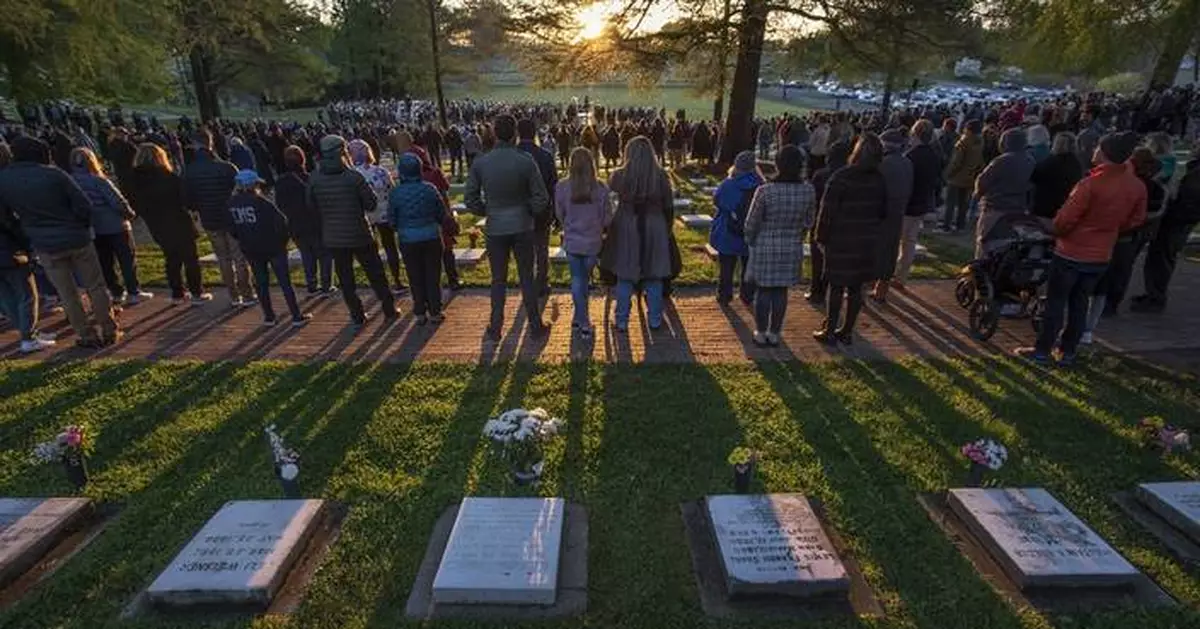On Easter morning, many Christians wake before dawn to celebrate their belief in the resurrection of Jesus, the son of God — as the sun rises.
They gather outside on beaches and church lawns, in local cemeteries and national parks, marking the holy day at the very core of Christianity. For the majority of the world’s Christians, Easter Sunday — and in turn, the sunrise service tradition — will be observed on March 31 this year.
Easter is not a fixed date. It swings between March 22 and April 25 based on a calendar calculation involving the moon.
The U.S. Conference of Catholic Bishops explains further: “Easter is celebrated on the first Sunday after the Paschal full moon, which is the first full moon occurring either on or after the spring equinox (March 21).”
That means sunrise service attendees will be waking up early on the last day of March this year.
There is biblical symbolism in the Easter worship of the early risers.
In the New Testament’s four Gospels, the resurrection story varies, but all tell of the four women followers of Jesus who discovered Christ’s empty tomb at dawn, said the Rev. Ginny Tobiassen, pastor of Home Moravian Church in Winston-Salem, North Carolina, where one of the most well-known sunrise services is held.
“When we as Christians stand in a graveyard at dawn, we are saying we believe in the resurrection. We are here among our dead, celebrating the resurrection,” she said.
It’s a message members of the Moravian Church — one of the oldest Protestant denominations in the world — have sent for nearly 300 years.
It is unclear if the Moravian Church was the first to hold an Easter sunrise service. As Tobiassen pointed out, it is an obvious choice given the Gospel stories about the early morning visit to Jesus' empty tomb.
But the denomination’s annual tradition dates to 1732 in Herrnhut, Germany, where Moravian refugees of religious persecution fled to and established the original Renewed Moravian Church settlement, according to accounts of church history.
For the first year, the single men gathered for an all-night prayer vigil, ending with hymn singing in the graveyard they referred to as “God’s Acre.” They invited the whole community the following year, and missionaries spread the tradition beyond the settlement, including to North Carolina.
In the 1750s, Moravians settled in what would become present-day Winston-Salem, North Carolina. The city is now home to one of the oldest Easter sunrise services in the U.S. It's known to draw thousands of people — not only Moravians but everyone from the curious to the spirituality seekers, Tobiassen said. It also can be watched online and heard on the radio.
“People who just want to know what is this thing that Winston-Salem has been doing all this time,” she said. “It’s very much a part of our community’s history.”
Started in 1772, this year will be No. 252.
The sunrise service is put on by the Salem Congregation, which represents 13 Moravian churches in the city, including Home Moravian Church where Tobiassen serves as minister. In addition to the longstanding liturgy, the service includes a silent procession to the Salem Moravian Graveyard, also called “God’s Acre,” and concludes among the graves that go back generations.
While Moravians hold their sunrise services in church graveyards, others hold them elsewhere and in various worship styles, including at Mount Rushmore in South Dakota, the Lincoln Memorial in Washington and on Newport Beach in California.
Yes. Moravian congregations are known for their trombone choirs made up mostly of brass and some wind musicians, Tobiassen said, and so the sunrise service will feature a band of about 300 horn players from churches in the region paying Moravian hymns together. Many of those musicians will have been playing all night, she said. They spread out on street corners, creating a cascade of sound throughout the community as they take turns playing lines of antiphonal hymns, she said.
“The idea is they are alerting people in the community to wake up — the Lord has risen. It’s time to gather,” Tobiassen said. “Their playing expands the worship space. If you can hear a horn, you’re in church.”
Yes. Some Christian faith groups hold an Easter vigil between sunset Saturday and sunrise Sunday, which can include a renewal of believers' baptismal vows. In some instances, Easter vigils and Easter sunrise services are one and the same.
The Episcopal Church also calls Easter vigil the “Great Vigil.” In its tradition, the service includes a four-part liturgy that the church describes as recovering "the ancient practice of keeping the Easter feast.”
It's explained further on the church's website: “Believers would gather in the hours of darkness ending at dawn on Easter to hear scripture and offer prayer. This night-long service of prayerful watching anticipated the baptisms that would come at first light and the Easter Eucharist. Easter was the primary baptismal occasion for the early church to the practical exclusion of all others. This practice linked the meanings of Christ’s dying and rising to the understanding of baptism.”
Associated Press religion coverage receives support through the AP’s collaboration with The Conversation US, with funding from Lilly Endowment Inc. The AP is solely responsible for this content.

FILE - The Pieta statue is seen as the sun rises during St. Patrick Roman Catholic Church's annual Easter Sunday service at sunrise at Our Lady of Calvary Cemetery in Pottsville, Pa., on Sunday, April 17, 2022. On Easter morning, many Christians wake before dawn. They will celebrate their belief in the resurrection of Jesus, the son of God, as the sun rises. (Jacqueline Dormer/Republican-Herald via AP, File)

FILE - The word "Jesus" is displayed on a large monitor and worship songs are played on stage as people gather for the "Easter Sunrise Service" at the Lincoln Memorial, Sunday, April 9, 2023, in Washington, hosted by the National Community Church. On Easter morning, many Christians wake before dawn. They will celebrate their belief in the resurrection of Jesus, the son of God, as the sun rises. (AP Photo/Carolyn Kaster, File)

FILE - A parishioner is silhouetted against the rising sun as she prays during an Easter sunrise service held by Park Community Church Sunday, April 4, 2021, at North Avenue Beach in Chicago. On Easter morning, many Christians wake before dawn. They will celebrate their belief in the resurrection of Jesus, the son of God, as the sun rises. (AP Photo/Shafkat Anowar, File)

FILE - Worshippers listen to the liturgy as the sun rises over the Salem Congregation's God's Acre graveyard during the 251st Easter Sunrise Service of the Moravian Church, Sunday, April 9, 2023. On Easter morning, many Christians wake before dawn. They will celebrate their belief in the resurrection of Jesus, the son of God, as the sun rises. (Walt Unks/The Winston-Salem Journal via AP, File)

















